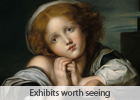-
-
VINCENTAS VASILIAUSKAS (1895-1989) – sniper, shopkeeper, painter
A self-taught artist Vincas Vasiliauskas (1895–1989) started painting only after he had retired. An elderly man with a primary education had already lived through most of his complex biography, actually had done every job he could, from a shopkeeper, a sniper to a meat chopper, had survived the war and Siberia, had brought up children and grandchildren. Only after having accumulated the wisdom of experience did the passion for painting burst forth, even though with no artistic education. The artist’s legacy covers almost 400 works, each one encompassing absolutely complete and meticulously presented worldview.
What are the paintings of V. Vasiliauskas about? I think of a simple formula of quite complex life, honest, like a child's, gaze at the environment, people, city, nature, everything that surrounds us every day and often passes by unnoticed. Every image is extremely deep, benevolent, spontaneous, conveying the crave for life, joyfully absorbing every detail, gathering all the crumbs of life. Sharper sensations occur only when a fierce breeze takes its start, however, in most cases a strong sense of what is being spoken, and a palette of natural tones are maintained.
In terms of genres, V. Vasiliauskas' paintings follow the tradition – landscapes, still lifes, portraits; gouache, oil, watercolours on paper or cardboard. Everything is as simple as that. However, every piece seems to explode from the power of a concept, when striving for a complex task of expression. Generally, landscapes combine several grounds: be it winding river loops, ascending paths, or numerous forest and hill massifs. When painting tree crowns or grass-plots the artist subtly applies short brush touches by means of which detailed and specific trunk lines blend into luminous openworks. Obviously, the author is not looking for an easy way of expression, instead, he is seeking for a highly individual, authentic solution. The author is aware of how complex his landscape structures are rendered and what idea they are to deliver. Buildings and trees are very cute in their chaotic perspective which is strengthened by carefully drawn details. But the fight between architecture and nature is won by the latter; it is nature that is imposed with the warmest feelings and sincere admiration. Alongside, there are landscapes in which interchangeable, captivating forms of nature resonate with rich generalized tones and bring the image closer to an abstraction and colour painting.
Landscapes usually feature vast panoramic views, while still lifes capture the coziness of home, fragrant dinner at the family table or bouquets of flowers. The most favourite for the artist are local colours which when creatively nuanced compose an integral whole of the palette. Each object has its own brush structures, in texture and form. Energetic strokes spread inexhaustible energy. The perspective is, of course, inconsistent, contorted: e. g., we observe a vase en face, the table is seen from above, the contours of the room appear in a reverse perspective. The forms follow headlong each other and leave behind, as if wishing to convey as much as possible.
Figures and portraits for V. Vasiliauskas are, perhaps, the most difficult tasks. They reveal the most striking deformations – the distinguishing feature of the so called Sunday artists. Nevertheless, the irregular anatomy of a body or portrait is painted both confidently and inspirationally.
The outsider art is no surprise in the world of art. The focus on self-educated artists continues to grow, it is especially evident in recent years, when the Smithsonian Museum of American Art hosted an exhibition Between the Worlds: Bill Traylor's art (2018), and the Los Angeles County Museum of Art LACMA presented The Outsiders and the American Avant-garde, exploring the mutual influences of self-educators and professionals. In this way, self-taught creation which has traditionally received less attention is being recorded in the circulation of art consumers and glorified in all the colours of its vivid worldview.
In Lithuania, we do not yet have a comprehensive study on self-taught art and exhibitions. It is true that samples of such art are sometimes included in professional art exhibitions, they are purchased by museums, even solo presentations are being held. However, no closer analysis has been made yet. So, let's include the name of the elder V. Vasiliauskas alongside Petronėlė Gerlikienė, Monika Bičiūnienė, Elena Kniūkštaitė, Adelė Velykienė, Algimantas Stankevičius, Lionginas Šepka and other Lithuanian painters, sculptors and masters who beautify the world with their works and do not strive for compensations.
Birutė Pankūnaitė. About the Thirst of Being: essay from the book ‘Vincentas Vasiliauskas – Sniper, Shopkeeper, Painter’ (Baltos lankos, 2020).
-
Virtual Exhibitions






